Aquarium decor: types and applications
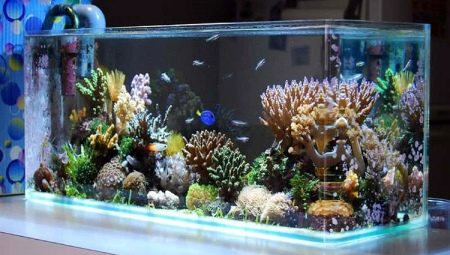
Making an aquarium is no less exciting process than breeding the inhabitants of a home mini-reservoir. It is interesting not only to observe the underwater life, but also to create decorations for it with your own hands. Whether it will be with the wreckage of the legendary ship, or it may turn out to be a reservoir in the spirit of Japanese minimalism - it's up to you. There are a lot of options and ideas, and you can dilute this many with an individual style and a unique concept.
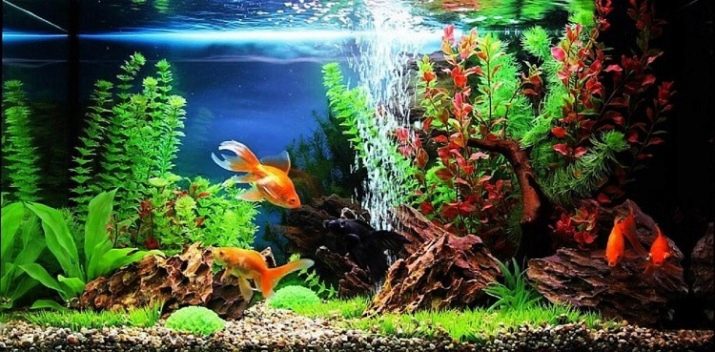
What materials can you use?
Those who are just trying themselves in aquascaping, appreciate the work of other masters, look at the pictures and often cannot believe that all this can be done with their own hands. The first step is to acquire an aquarium, the second is to develop a decorating plan. Advise first, look through the many options that will create a kind of aqua design base, help you navigate in the direction that is most preferable for you.
Aquascaping has its own rules. The choice of style and composition is, of course, very important, but the design in the aquarium is always secondary. In the first place is the organization of optimal living conditions for underwater inhabitants.
If something in the design of the aquarium disrupts the life of fish and other quicksands, you will have to part with the unwanted element.

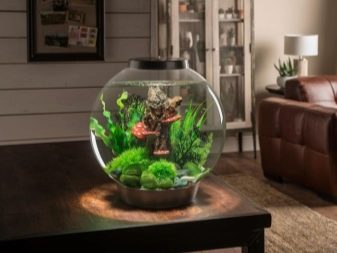
The basic materials for decoration include the following:
- metal;
- organic;
- glass and ceramics;
- rock and minerals;
- plastic, foam and rubber.
Important! It is worth paying attention to how the material interacts with the natural environment of the aquarium.If it makes the reservoir more beautiful, but harms the biobalance of the underwater kingdom, the material is not suitable.
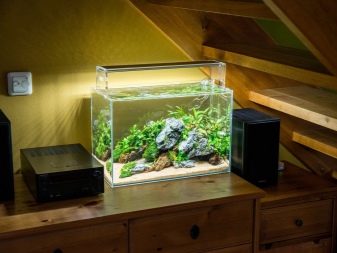
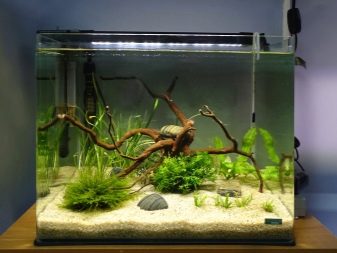
Most metal objects immersed in water are susceptible to oxidation, which can spoil the composition of the water. If the metal is covered with protective equipment, it no longer looks so dangerous. But varnishes and paints eventually become covered with microcracks, which means that the water will still be contaminated with oxidation products. Fortunately, metal is not used extensively in aquarium décor. Mostly metal elements are included in filters and heaters.
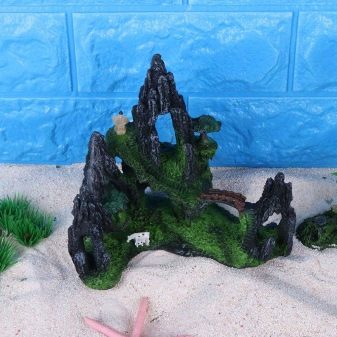
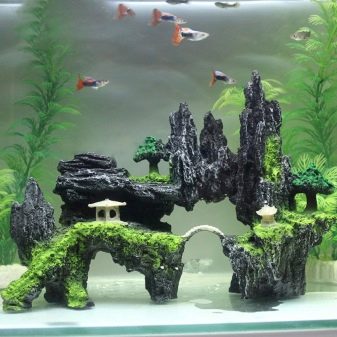
Organic matter is, of course, driftwood and tree roots. They mimic the coastal sector of water bodies. Minerals and rocks are primarily stones that do appear frequently in reservoirs. Mosses are often grown on the stones, which also decorates the container.
In a mini-pond, quartz, syenite, as well as flint and basalt are well settled. They can be considered neutral with respect to the composition of the water. The stones found in their natural environment should be prepared for launching into the pool - washed with a coarse brush, kept in a separate container filled with aquarium water for a week. Cement and gypsum are chosen less frequently than, for example, ceramic pots. The latter are turned over, chipped off a piece so that the fish can swim inside.
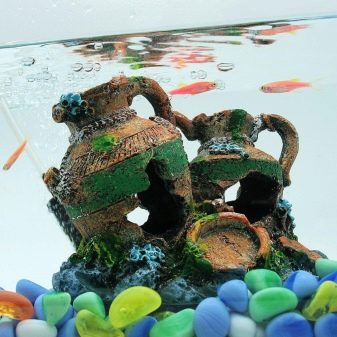

Choosing an aquarium background
The most popular option for the back wall is considered laminated film, which depicts rocks, plants and other decorations. This film can be purchased according to the size of the tank. The film gives the reservoir a more natural look, does not negatively affect the condition of the underwater inhabitants.
The background can be one-sided and two-sided.
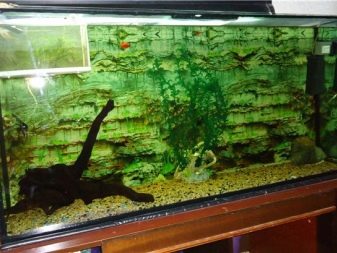
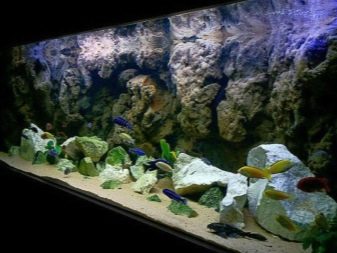
If you don't like the laminated film option, take a look at wrapping paper. It is suitable for creating a self-made backdrop. Quite often aquarists use scrapbooking paper, which really makes the result unique - the background turns out to be very unusual and stylish. If the background does, you think, should be minimalistic, then you can cover it with a sheet of dark blue paper (or even paint over it simply).
But the transparent back wall is usually not left: there are shy fish that may be afraid of their own reflection.
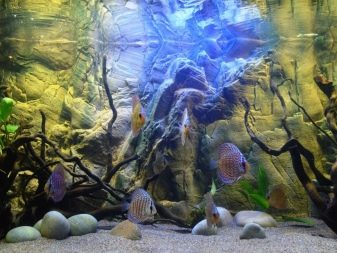
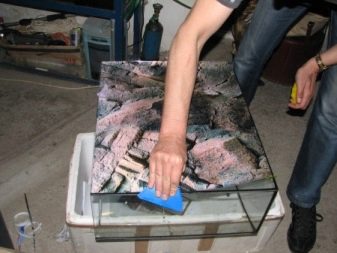
Varieties of soil
For aquarists who are demanding on the vegetation in the tank, the most important are neutral soils. These are, for example, river pebbles, coarse sand, basalt and quartz chips. In this substrate, plant roots are fixed. Vegetable debris is collected there, as well as waste products of the inhabitants of the underwater kingdom.
If you ignore the soil layer, the water will quickly become cloudy, and algae will multiply in it at a cosmic speed.

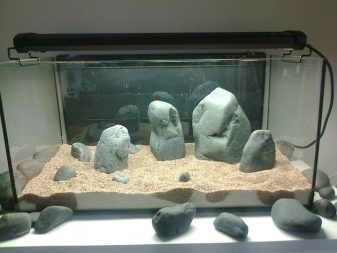
Nutrient soils represent either a vitamin substrate or a granular earthy substance. If the substrate is with laterite, it will be rich in iron, if it is peat, it contains a lot of nitrogen and phosphorus, if it is clay, it is enriched in potassium. Some species of fish live only in the sand, they even swallow quartz sand to improve digestion or burrow into the sandy mass for spawning. The good thing about sand is that it makes the aquarium environment related to the natural one. The roots of plants can firmly anchor in the sandy substance, a fertile environment is formed in it.
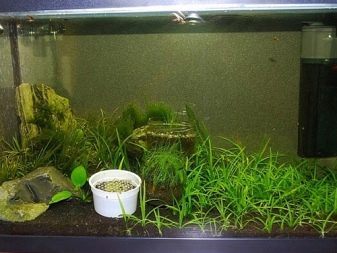

And then there are black and white soils. Black is a purely decorative material (shugnite + basalt + granite). But he has a minus - the water can turn gray. Granite also has magnetic properties that are not always safe for fish. Therefore, the option only from quartz is the most optimal.
White soil is easily soiled. For example, if you treat fish and send medicines with a dye in the composition into the water, they can paint over the soil. If you choose natural white soil, it is most likely limestone.It dissolves in water with the help of organic acids, which makes the water hard - and not all fish will like it.

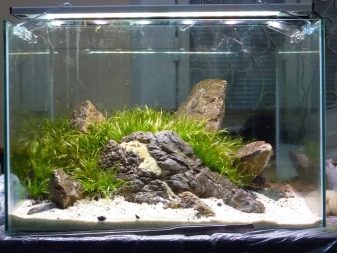
What stones are right?
For aquariums usually use granite, solidified magma, quartz, petrified wood, slate and slate. It is worth noting large pebbles, but they still more relate to the ground than to decorative stones in an underwater house. Stones such as:
- alabaster;
- marble;
- dolomite;
- limestone;
- coral;
- crushed shells;
- different types of sandstone.
These are carbonate rocks of stones, to make sure that the found stone belongs to them, apply a few drops of white vinegar to its surface. If the liquid starts to sizzle, bubble, there is carbonate in the rock. All stones need heat treatment before lowering them into the aquarium. If the stone is heavy, do not touch it to the glass. This is a common mistake of novice aqua designers: tank glass can break under the pressure of large decorations.
Arrange stones evenly, do not pile up.
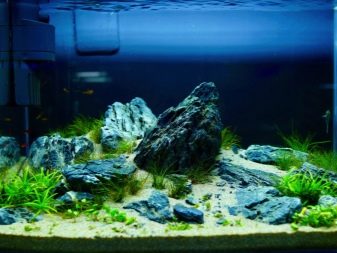
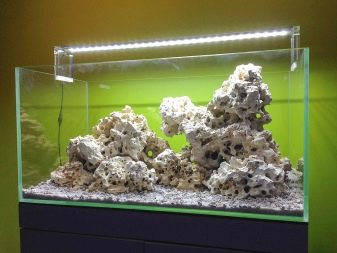
Wooden driftwood as a decor for an aquarium
If you've ever seen a Japanese-style aquarium, you've probably noticed how surprisingly organic driftwood looks in a confined water space. In fact, in order to create such a harmonious picture, you need to have a good artistic taste. The minimalism of the underwater landscapes is so beautiful that there is nothing superfluous there, and everything that is available is carefully selected. Treat snags as responsibly as possible.
So that they take root in the aquarium and do not harm it, you need to choose hardwood, not coniferous, well boiled in salt water and dried in the sun. To decorate the tank, only a “dead” tree is used, which has been in nature for a long time, getting rid of bark and juices. Rotten places on the snag are a reason to abandon such organic matter.
If you yourself do not want to look for suitable samples, you can buy a similar decor at a pet store.
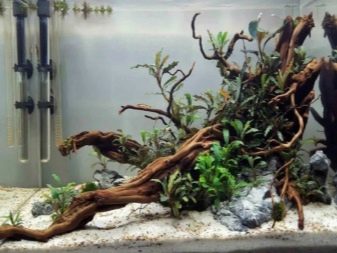
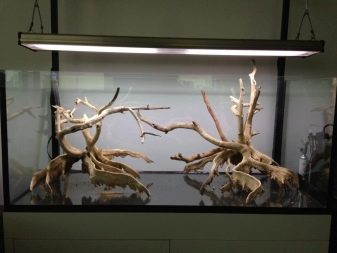
Live and artificial plants
Don't be afraid to use artificial flora in your aquarium. Many modern elements look so natural that you will never guess their true origin. In addition, not all real plants are able to get along with the inhabitants of the aquarium; fish come into conflict with artificial flora less often. If you make a rating of the most beautiful plants for a mini-pond, the following varieties will surely fall into it:
- red pinnate;
- eriocaulon;
- wavy crinum;
- vallisneria;
- patterned hygrophila;
- riccia;
- javanese moss.
Artificial water lilies look great in an aquarium of different sizes and types. They are made multi-colored, expressive, catchy. Fish are indifferent to them - they do not touch them, do not spoil them, but they can be used as hiding places.
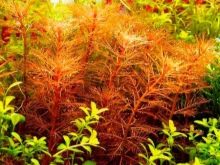
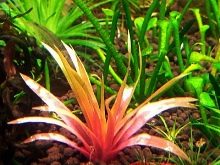

Shells and corals
Try to buy such decorations only in specialized stores, and not in souvenir shops, where such items are varnished. Placing such a shell in an aquarium can poison the underwater inhabitants. To disinfect and process such decorations, it is worth performing such actions as:
- corals can be boiled in boiling water, then rinsed by rubbing with a soft brush;
- shells with a mother-of-pearl surface cannot be boiled; for this purpose, it is customary to leave them on the anthill for 4 hours in order to remove intra-shell debris;
- coral reefs are soaked in water for two weeks, renewing the water from time to time.
Gorgonians are not suitable for decorating an artificial reservoir: in fresh water, alas, they rot.
Shells and corals lead to an increase in water hardness, which should be taken into account when choosing fish.
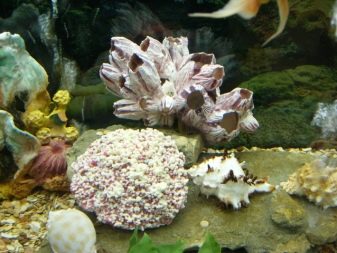

Other items
The decor of the mini-reservoir is often sunken ships overgrown with moss and algae, in the openings of the windows of which you can see chests with gold. These are mermaids-sirens, who have dragged more than one man into the maelstrom, these are underwater rocks, and huge artificial crabs of bright colors.Original aquariums for those who put some artistic idea into the design concept. Someone only contains an herbalist aquarium, in which there are no living inhabitants, but impressive large black fish (artificial) swim or somewhere at the very bottom there is a steadfast tin soldier.
Someone turns the herbalist into an underwater mermaid kingdom, where a whole family of mermaids lives, like a living personification of Andersen's famous fairy tale. Fancy and plastic jellyfish, covered with a special film for phosphorescence in the dark. There may be a chest with pearls or a bottle in which the almighty gin is hiding in the underwater gardens.
A fabulous theme in the design of aquariums is more than appropriate.
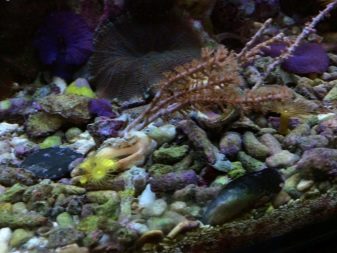
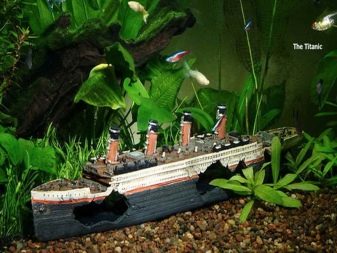
Choice of jewelry
Consider designing your aquarium in a recognizable style, such as Egyptian. The background is made in the form of mysterious images on the walls; in the tank itself there are pyramids, ruins and fragments of amphorae. Orange soil options will look organic in this style. A small pool needs minimalism. If there is, for example, a sunken ship there, you should not add other decorations to the bottom.
Ship will become the semantic center of the composition, the rest is just playing along with him. Try to buy jewelry from specialized stores. Various toys may not be suitable for placing in water, especially one where living things live.
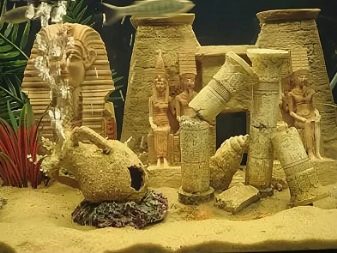

Use in design
It is very important how the aquarium will look in the interior. If you buy it for children, it can be a good decoration in the nursery. But the children need to be adults and understand what is possible in relation to the aquarium and what is not. It is believed that starting from the age of 8, the child already has a responsible attitude to such a living corner and can, together with his parents, take care of it, arrange the decor in it in its places. If you want an aquarium in the nursery where preschool children grow up, we recommend purchasing artificial, dry aquarium - it can also be decorated, it is interesting to arrange elements. It is a beautiful and safe nursery decor.
In the living room, you can also focus on the aquarium. You can decorate the backdrop with your own hands, choose the right color scheme, establish good lighting - in a word, you can conjure with accents. He, the aquarium, will control the gaze of everyone who enters the room. It is important to treat the outside of the tank so that it shines clean and fresh.... A couple of decorative stickers in the theme also do not interfere, for example, Ocean and National Geographic channel logo stickers. There are craftsmen sticking on the glass outside figurine of the famous Jacques Yves Cousteauand it's really original.
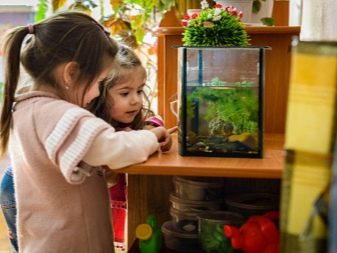

You can find out how to assemble an aquarium below.








